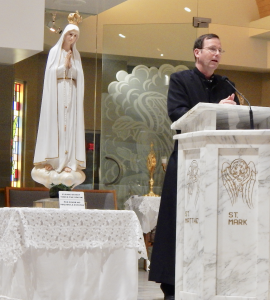 The Visitation of Our Lady to Saint Elizabeth, which is the second Joyful Mystery, offers to all of us abundant spiritual riches or treasures to encourage us on our journey to heaven and to grow daily in holiness of life.
The Visitation of Our Lady to Saint Elizabeth, which is the second Joyful Mystery, offers to all of us abundant spiritual riches or treasures to encourage us on our journey to heaven and to grow daily in holiness of life.
First, there is a close connection between the Annunciation and the Visitation. Once Our Lady says Yes to God through the Archangel Gabriel, then Our Lady conceives Jesus in her most pure womb through the overshadowing of the Holy Spirit. Our Lady teaches us the importance of purity of heart, mind, body and soul. She also teaches us to be open and docile to the Holy Spirit. Finally, Our Lady teaches us that true joy can only come from our saying Yes to God.
Second, Our Lady becomes a contemplative in action. What this phrase means is that what Our Lady contemplated and assimilated in prayer she put into practice. This is a daily challenge for us as followers of Christ — to imitate Mary, not simply in praying but also in doing! If we pray and do not act, then we are sending an incomplete message. Our Lady’s prayer life anointed and overflowed into her active life. In other words, we are called to live out the greatest of all commandments like Mary — to love God with all of our heart, mind, soul and strength — but also to show our love for God by the love we show towards our neighbor.
Third, Our Lady went in haste. In the Divine Comedy, in Purgatory where Dante is being purged of the seven capital sins, the classical writer contrasts how Our Lady lived the opposite virtues of the capital sins. With respect to sloth or laziness, Our Lady moving in haste to visit her elderly cousin in need, presents to us the virtue of diligence or fraternal charity that she carried out without a moment’s hesitation. How often do we put off acting, procrastinate, say “I will do it tomorrow” and thereby waste the many graces that God has in store for us! May Our Lady who moved in haste encourage us to conquer our laziness!
Fourth, while moving in haste to visit her cousin Saint Elizabeth, Mary teaches us to love Jesus in the Eucharist. She said Yes to the angel and received Jesus into her heart and body, but then she became a living Tabernacle, a living and moving Eucharistic procession, a true CORPUS CHRISTI in her very person. May Our Lady teach us to receive Jesus with love in Holy Communion and then to respect Him in our bodies and the bodies of others.
Fifth, Mary teaches us the value of sacrifice. Geographically, Our Lady had to travel approximately 80 miles on foot to visit her cousin. No car with air-conditioning and soft, gentle music; no restaurants along the way; nor any hotels — Our Lady had to “rough it” and sacrifice on this long and challenging journey.
Sixth, Our Lady had to climb or ascend to arrive at Ain Karim where her cousin Elizabeth resided. This is symbolic of our spiritual life– that is to say, that all of us have to climb or ascend in our spiritual lives. We all have to climb our own Calvary and carry our own cross. The secret to spiritual victory is to climb and ascend and to carry our cross with Jesus and Mary. Jesus said: “My yoke is easy and my burden is light.”
Seventh, Whenever we travel in our spiritual lives the should never go alone. Rather, we should invite Our Lady to travel with us; she is the best of travel companions. Her company is gentle, sweet, charming, encouraging and she will help us to arrive safely at our destination. Especially it is so true that we are pilgrim-travellers in this life heading towards our eternal destiny which is heaven. May Our Lady help us to attain this most important goal!
Eighth, Greetings are important! Upon arriving at the home of St. Elizabeth, Our Lady takes the initiative to greet her cousin— possible with the word SHALOM, which means, Peace be with you! Our Lady teaches us the art or friendliness. All too often we wait for others to greet us; whereas if we were truly humble we would take the initiative to first greet the person that is approaching us in imitation of Mary. Mary was charming, friendly, kind, observant, loving, and truly cared for the well-being of others. May we learn these lessons and imitate her.
Ninth, PRO-LIFE PASSAGE– par excellence! Mary greets her elderly cousin who is with child and the baby(St. John the Baptist) leaps for joy. Elizabeth respond: “Who am I that the Mother of my Lord should come to me. At the sound of your greeting the baby leapt for you.” Both Mary and St. Elizabeth teach us the importance of respecting human life, from the moment of conception until natural death. In the modern American society both Mary and Elizabeth would be prime targets for the abortion proponents. Why? Mary was of course too young to have a child, because most probably she was a mere teenager; Elizabeth, the other extreme, would be way to old to have a child and could easily jeopardize her life as well as that of the baby. However, we all know th ending to both of these stories! Saint Elizabeth gave birth to Saint John the Baptist, the “greatest man born of woman”; Mary, gave birth to Jesus the WAY, TRUTH, AND LIFE AND SAVIOR of the world! May these great women teach us to trust in God’s providential plan for every unborn child!
Tenth, prayer is of primary importance. In the context of the Visitation and Our Lady’s conversation with Elizabeth, a song or canticle of praise explodes from the depths of the Immaculate Heart of Mary. We call this the MAGNIFICAT. “My soul magnifies the Lord and my soul rejoices in God my savior…” May Our Lady teach us to praise, worship, glorify and thank God at all times an in all places for the wonders He has done in all of us. Saint Louis de Montfort suggests that we pray the prayer the Magnificat after receiving Jesus in Holy Communion as a prayer of praise and thanksgiving! No better way to praise God then through the Immaculate heart of Mary!
Eleventh, Our Lady teaches us the importance of service. Jesus Himself reminds us: “The Son of man did not come to be served but to serve and to give His life in ransom for man.” The several months that Our Lady spend with Saint Elizabeth we can easily imagine what Our Lady would have been doing as she awaited and prepared for the birth of Saint John the Baptist. Fetching the water at the well, cooking, cleaning, sweeping, washing, ordering, and many other household tasks Our Lady would have carried out with order, method, and of course with great love for God and her cousin. How many housewives must carry out these somewhat mundane and tedious chores of their vocation. Mary Our Lady teach us to do the ordinary chores of our daily life with extraordinary love. Sanctity does not depend on doing great things, but in doing the small things of our daily vocation with love. This was the essence of the spirituality of St. Therese but also of Our Lady.
Twelfth, Our Lady of course maintained frequent conversation with Saint Elizabeth. Therefore, Mary teaches us the art of conversation. At all costs we should always avoid the sins of the tongue, especially that of gossip. Try to imagine a typical conversation between these two holy women and beg for the grace to imitate them. Every word that issues from our mouths will be judged by the Lord on the judgment day. May Our Lady help us to purify our speech and conversation patterns.
Thirteenth, Our Lady, not only would help to prepare the meals, especially dinner, but she would share meal-time with Elizabeth and Zechariah. In our modern world, characterized by so much hustle and bustle, in which families no longer have time to sit down and enjoy a meal together as the sun goes down, Our Lady teaches us the importance of cultivating the family by the sharing of meals together and family conversation. How many young people today feel abandoned and have recourse to drugs, porn, and drink due to a lack of time and attention that their parents should provide for them.
Fourteenth, Mary’ silent example was most edifying. Mary’s simple example of prayer, work, attention, kindness, imbued by the Holy Spirit, without a doubt was a strong inspiration for Elizabeth or for anyone who came in contact with Mary. Mary teaches us to preach the Gospel message by both word and by the example of our lives.
Fifteenth, Mary helped in the birth of Saint John the Baptist and rejoiced with Elizabeth and Zechariah who would finally recover his speech. Our Lady teaches us all to help the struggling, promote Pro-Life, as was mentioned earlier, to encourage the struggling as in the case of the mute Zechariah and to be present to others to help them to carry their crosses. In our lives, in which we all have to carry many crosses, let us turn to Mary and ask her to be present to us and for us. Indeed Our Lady is our life, our sweetness and our hope.


Father Ed Broom, OMV, is Associate Pastor of St. Peter Chanel Church in Hawaiian Gardens, California. He is a member of the Oblates of the Virgin Mary and was ordained by Saint John Paul II on May 25, 1986. Fr. Ed teaches Catholic Ignatian Marian Spirituality through articles, podcasts, a radio show, retreats and spiritual direction.